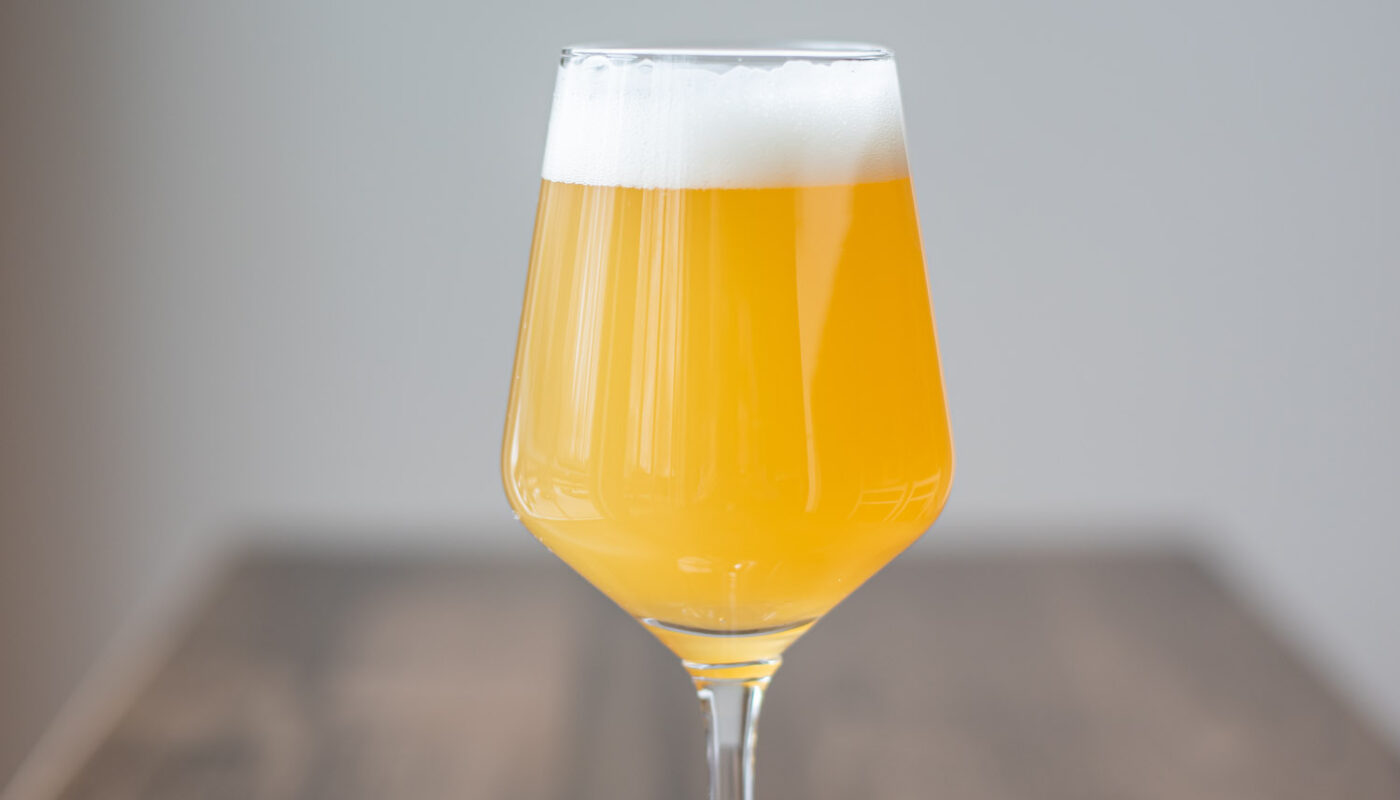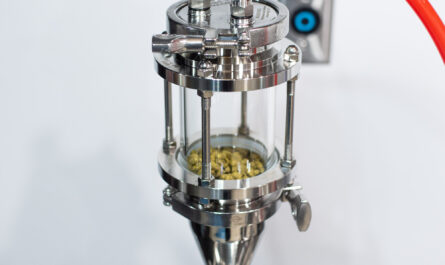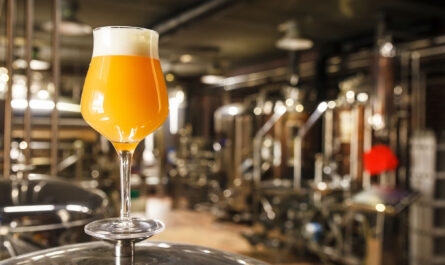This has been my favorite New England IPA recipe I have brewed to date. Imperial’s Dry Hop yeast honestly steals the show and throws so much tropical fruit and funky esters. It’s loaded with pineapple, mango, and passionfruit. It features a nice creamy head, perfect lacing, and beautiful color thanks to golden naked oats. It’s juicy with a creamy pillowy finish without being overly murky despite being a heavily oated recipe.
Here’s a link to the recipe in Brewfather.
Ingredients
Fermentables
10 lb – Pilsner Malt 1.8 °L (69%)
2 lb 8 oz – Oats, Flaked 1.6 °L (17.2%)
1 lb – Golden Naked Oats 7.3 °L (6.9%)
1 lb – Wheat White Malt 2.3 °L (6.9%)
Whirlpool
30 min hopstand @ 180°F
30 min 180 °F – 2 oz – Galaxy – 14% (17 IBU)
30 min 180 °F – 2 oz – Mosaic – 12.25% (15 IBU)
Dry Hops
7 days – 4 oz – Galaxy – 14%
7 days – 4 oz – Mosaic – 12.25%
Yeast
2 packs Imperial Yeast Dry Hop A24
Other
Whirlfloc – 15 minutes
Water Profile
Ca2+ 93
Mg2+ 2
Na+ 24
Cl– 157
SO42- 49
HCO3– 43
Specifications
Method: All-grain
Batch size: 5 gallons
Efficiency: 70%
OG: 1.076
FG: 1.018
ABV: 7.6%
IBU: 31
SRM: 5
Target Mash pH: 5.3 (adjust with lactic acid)
Mash Temp: 154°F – 60 minutes
Boil: 60 minutes
Fermentation Temp: 68°F
Notes
Day 1: Pitch yeast at 68°F and let rise to 72°F on day 2-3 for the remainder of fermentation. Should finish in 4-5 days.
Day 6-7: Drop the temperature to 60°F and hold for 24 hours.
Day 7-8: Add dry hop charge, hold at 60°F at 7-10 PSI.
Day 14: Crash to 35°F for 48 hours. Proceed with packaging/cold conditioning for another week in the keg at serving temps. Should be prime drinking by day 20.
This recipe puts 5 gallons into the fermenter but honestly the final yield may vary due to the heavy dry hopping. Expect a decent loss from this.
Use code HAZY20 to get 20% off your entire purchase of $100 or more at yakimavalleyhops.com.





Can you provide this in BeerXML.
Quick question, when you add the dry hops in your recipe above, are they sitting in there for 7 days or do you pull them after 2-3 days?
I keep them in contact for 7 days. Going to experiment with rousing the hops every 2 days next batch. Stay tuned.
Sounds good! I’ve been doing 2 days of contact time in the fermenter, then pull and it’s been fairly good. Did a split batch the other week and turned out great. The one batch got oxidized and I think the issue might have been the serving keg. I’m going to try the star san method in the keg to clear the space and see if that improves. That seems to be the only area that would be of concern in my process. Even when I dry hop, I hit the top of the fermenters with CO2 for a solid time before getting the lid shut. I know it works because during HK dry hop, the fermenter bubbles immediately again once the lid is closed. Always nice to see feedback from others on their process!
Did you mean A24 for the yeast strain? I wasn’t sure if there was an A26 seasonal variant or something I missed.
Sure did – thanks for pointing that out.
Hi, what about hop creep adding hops after fermentation?
I honestly think you’ll be fine if you follow the notes I outlined above.
Hey thanks for all the great info on brewing IPAs. I was just curious what your thoughts were on hopping directly in the serving keg? I know the madfermentationist and scott janish were pretty big proponents of it (at least a couple years ago).
I’ve done it once or twice and in general I think it works. It will fade very fast however. You will likely get some subtle vegetal notes since the temp is so cold however it can add bursting aroma and flavor 24 hours post hop. I’d try using cryo hops in the keg since you’re less likely to get those vegetal flavors.
Hey. Thank you so much for this recipe!!!! Do you have advice for folks without temp control? ie. fermenting too warm. I had two ideas. Fermenting under pressure which could suppress the negative impacts of high temps. Alternatively, using a kveik strain such as “voss” which is known for high temp capabilities. Any thought on this?
Temp control is really really important so I’d highly suggest you prioritize some sort of solution when you can. I’ve never used kveik however it’s on my list of strains to try. Pressure fermentation works well but it won’t yield the best results for a NEIPA. It’s going to suppress the ester qualities you need in the style. Kveik is prob your best bet outside of temp control but ovb can’t promise the same results as the strain I used. Hope this helps!
Hey Shawn thanks for sharing info about brewing. Love the videos they’re awesome. J have a question about dry hopping. I’ve noticed you just put the hops in the fermenter unrestrained. My question is how do you not get a clogged poppet or hose when you transfer the beer? I’ve tried that and it was a frustrating mess. Also I have just left hops in the serving keg the entire time and I loved it I don’t get that grassy veggy taste. I did cold crash beer to 33 degrees before racking to keg with hops on it. Anyways just curious about your dry hop process without a clogged transfer. Thanks
Hi Albert – are you fermenting in a keg or a conical? Honestly, I’ve had pretty good luck as long I crash for 24 hours before attempting any sort of transfer. I also add head pressure to the fermenting vessel. Dry hopping under pressure tends to help drop hops out of suspension faster if I understand correctly. This combo has worked out for me and I haven’t had any clogs. With a pressure transfer, sometimes a small clog can be pushed through.
Thanks for your reply. That’s one thing I need to try is dry hopping under pressure. I have a Spike Flex Plus conical without yeast dump. Will try that. Appreciate your site and videos has helped me tremendously.
Hey Shawn, just wanted to write that I had great success following a few things you listed with this recipe. I used your water profile and mashed at 154 and got great body, mouthfeel, and smooth taste with no chalkiness. I used Imperial’s A04 Barbarian yeast and it turned out great. I had complete fermentation in 3 days with a starter. I used 100% Citra Lupomax hops for whirlpool and 2, 3oz dry hops at day 7 and day 9 (pulled after 2 days each time). I did a quasi-experiment where the one batch was temp controlled and the other was keg fermented at room temp. I dry hopped the temp controlled batch at 55 degrees and the other was at 72 degrees. Did a few samples for friends and they both agreed that the 55 degree dry hop had a bigger aroma punch! Pretty fun experiment.
Thanks, Dan – really appreciate the feedback and really happy this one worked out for you.
Hi, I’m wondering if you could provide some feedback… I was super strict with following the recipe for this when I brewed it (given it was over $100aud in ingredients). It started off fairly good, lots of flavour and subtle sweetness just a few days after kegging. Now two weeks in the keg, it has lost majority of the hop character and is just overwhelmed by the alcohol. I’m wondering if you’ve had this before? Ive never encountered this with my other brews, they tend to get better over time. I’m about ready to pour it down the sink…
Good morning, i speak from brazil, its a incredible recipe, i will make this weekend. In my state i only have safale yeast us-04 and us-05. do you recommend me use 2 packages of US-04 or mix US-04 and US-05? thank you so much!!
I would use S04 over S05
Thanks for sharimg the recipe. Just want to let you know there is a typo in your brewfather recipe title “topical”
Thank you!
Nitpicking here, but the beer is called Tropical Vacation DDH NEIPA, but you only have one dry hop charge listed.
I realize this can be a little misleading. While you can certainly split the DH into two charges, this is a single larger DH of equal volume. This is more focused on the pure volume of dry hops rather than multiple charges. I think SOME breweries use this nomenclature to differentiate the pure volume of hops between small and big beers. My opinion of this has slightly shifted since originally publishing this recipe. I’m looking to go back to two consecutive chargers because it may lead to better extraction and flavor.
Shawn,
Thanks much for your article. I have been brewing nearly all New England style beers for the past 2 years.
I stumbled on the dry hopping at lower temps when I was in the middle of fermenting a beer and had to go out of town for a week. I thought I’d turn the temp down to try and eliminate getting too much bitterness. The beer came out great and I’ve been doing it ever since. Good to hear the pros do this too.
I especially like your comments about the high protein grains… oats and wheat. I’ve been experimenting in this area and your comments gave me some new direction to try.
As for your recipe… I’m planning to brew it soon but was a little surprised at the total amount of hops. I typically put in a pound or more for a high ABV beer. Any comments?
I’ve been slowly pushing the envelope on dry hopping. I’ve tried everything from 4-18 ounces per 5 gallons. It honestly depends on the ABV, grist, and goals. The more dry hops the greater beer loss and more vegetal notes you will get. You can experiment with more, but at the time I designed this recipe, that’s where I was at with my expirments. If I were to brew again, I’d consider a little more.
Thanks for posting this. I brew a lot of Kolsch style ales along with NEIPA and recently switched from keeping 50# of 2 row on hand to keeping Pilsner on hand. Recently I started doing NEIPA with the Pilsner vs the 2 row to get that light gold color and it has been brilliant. I think the Golden Naked Oats may be the missing link I have been looking for in my grain bill. Btw…I have been a 1318 devotee but your results with Imperial’s Dry Hop have me thinking I might do a mixed pitch.
Hi Shaun, looks like a great recipe, I will give it a go, with the 5 gallons into the fermenter what was the original amount of water in the boil, how much boil off of water was there in the process.
Thanks